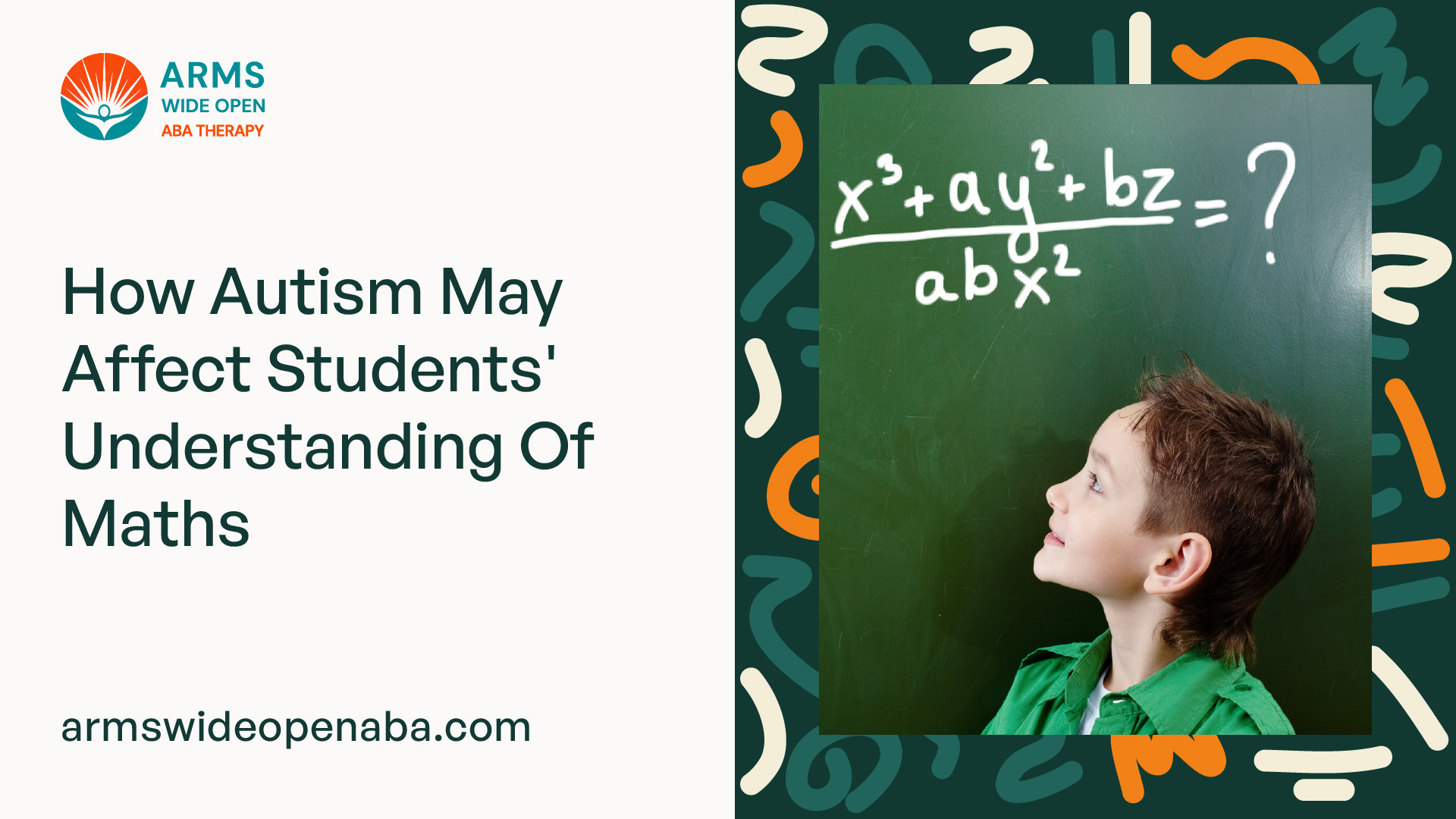How Autism May Affect Students' Understanding Of Maths
Unlocking the math maze: How autism shapes students' math comprehension. Discover strategies for success!

Understanding Autism and Math Comprehension
When it comes to understanding math, students with autism may face unique challenges that can impact their learning experience. In this section, we will delve into the basics of autism spectrum disorder (ASD), explore the relationship between autism and math skills, and discuss the common challenges faced by students with autism in the realm of math.

Autism Spectrum Disorder: An Overview
Autism spectrum disorder (ASD) is a neurodevelopmental disorder characterized by difficulties in social interaction, communication, and repetitive behaviors. It is a spectrum disorder, meaning that it affects individuals differently and to varying degrees. While the exact cause of ASD is not fully understood, research suggests a combination of genetic and environmental factors.
The Relationship Between Autism and Math Skills
Math skills can be particularly affected by autism. Some individuals with autism possess exceptional math abilities and demonstrate a talent for numbers, while others may struggle with various aspects of math comprehension. It's important to note that the challenges faced by students with autism in math do not necessarily reflect their intelligence or potential.
Common Challenges Faced by Students with Autism in Math
Students with autism may encounter several challenges when it comes to math comprehension. These challenges can vary depending on the individual and the severity of their autism. Some common difficulties include:
- Difficulty with abstract concepts: Understanding abstract mathematical concepts such as fractions, decimals, and algebraic equations can be challenging for students with autism who tend to think more concretely.
- Executive functioning deficits: Executive functioning skills, such as planning, organizing, and problem-solving, can impact a student's ability to approach math problems systematically and efficiently.
- Sensory sensitivities: Sensory sensitivities, commonly experienced by individuals with autism, can distract or overwhelm students during math lessons, making it difficult to concentrate and engage with the material.
- Challenges with social interaction: Collaborative math activities and group work may be challenging for students with autism who struggle with social interaction and communication skills.
- Difficulties with transitions: Transitioning between different math topics or tasks can be challenging for students with autism, who may require additional support and structured routines to effectively navigate these changes.
Understanding the unique challenges faced by students with autism in math is crucial for educators and parents to provide appropriate support and accommodations. By implementing strategies and interventions tailored to their specific needs, students with autism can be better equipped to navigate the math maze and develop their math skills.
Cognitive Factors Impacting Math Comprehension
When it comes to understanding math, students with autism may face unique challenges due to various cognitive factors. These factors can impact their ability to comprehend mathematical concepts and solve problems effectively. In this section, we will explore three key cognitive factors that play a role in math comprehension for students with autism: executive functioning, theory of mind, and central coherence.
Executive Functioning and Math Abilities
Executive functioning refers to a set of cognitive processes responsible for self-regulation, organization, planning, and problem-solving. Difficulties with executive functioning can significantly impact math abilities for students with autism. These difficulties may manifest as challenges in organizing their thoughts, following multi-step directions, and managing time effectively during math tasks.

Theory of Mind and Math Understanding
Theory of mind refers to the ability to understand and infer the mental states of others, such as their thoughts, beliefs, and intentions. Students with autism often experience difficulties in theory of mind, which can affect their understanding of math. This may result in challenges in interpreting word problems, understanding mathematical concepts from others' perspectives, and recognizing the need for mathematical reasoning.

Central Coherence and Math Processing
Central coherence refers to the ability to process information holistically and perceive the "big picture." Individuals with autism often exhibit a cognitive style characterized by a focus on details rather than the overall context. This cognitive tendency can impact math processing by hindering the ability to integrate multiple elements of a problem and comprehend the underlying mathematical concepts.

Understanding these cognitive factors can help educators and parents develop appropriate strategies and interventions to support students with autism in their math learning journey. By addressing executive functioning challenges, fostering theory of mind development, and promoting central coherence, we can enhance math comprehension and promote mathematical success for students with autism.
Sensory Considerations in Math Learning
When it comes to students with autism, sensory considerations play a significant role in their ability to comprehend and engage with math concepts. Understanding how sensory processing, visual perception, and motor skills impact math learning can help educators and therapists provide effective support for these students.
Sensory Processing and Math Performance
Sensory processing refers to how individuals take in and interpret sensory information from their environment. For students with autism, sensory processing differences can affect their math performance. Some students may be hypersensitive to certain sensory stimuli, such as bright lights or loud noises, which can distract them and make it challenging to concentrate on math tasks. On the other hand, some students may be hyposensitive, meaning they have a reduced sensitivity to sensory input, which can result in difficulties in recognizing patterns or distinguishing shapes and numbers.

Visual Perception and Math Comprehension
Visual perception plays a crucial role in math comprehension. Students with autism may experience difficulties in visual perception, which can impact their ability to understand math concepts. These difficulties can manifest in various ways, such as struggles with spatial reasoning, difficulty recognizing visual patterns, or challenges in understanding visual representations of mathematical operations.

Motor Skills and Math Engagement
Motor skills are also intertwined with math engagement for students with autism. Fine motor skills, which involve precise movements of the hands and fingers, are necessary for tasks such as writing numbers or manipulating objects during math activities. Difficulties with fine motor skills can impede a student's ability to complete math assignments independently. Furthermore, gross motor skills, which involve larger movements of the body, can impact a student's overall engagement in math activities.

Understanding the sensory considerations in math learning for students with autism is crucial for providing appropriate support. By addressing sensory processing differences, visual perception challenges, and motor skill difficulties, educators and therapists can create a learning environment that promotes better math comprehension and engagement for students with autism.
Strategies to Support Math Learning for Students with Autism
For students with autism, it is important to implement effective strategies that cater to their unique learning needs. In the context of math education, there are several approaches that can support their math learning journey.
Individualized Education Plans (IEPs) and Math Goals
Individualized Education Plans (IEPs) play a vital role in providing personalized support to students with autism. These plans outline specific goals and objectives for each student, including their math learning objectives. By tailoring the curriculum and teaching methods to the individual's strengths and challenges, educators can create a more inclusive and supportive learning environment.
To enhance math learning for students with autism, the IEP may include the following goals:

Multisensory Approaches to Teaching Math
Multisensory approaches are effective strategies for engaging students with autism in math learning. These approaches utilize multiple senses, such as visual, auditory, and tactile, to reinforce math concepts and enhance comprehension.
Some examples of multisensory techniques in math education include:
- Using manipulatives: Introduce tangible objects like blocks, counters, or math manipulatives to help students visualize and interact with mathematical concepts.
- Incorporating movement: Incorporate physical movements or gestures while teaching math to reinforce understanding and facilitate kinesthetic learning.
- Employing technology: Utilize educational apps, interactive software, or online platforms that offer visual and auditory representations of math concepts.
Visual Supports and Math Concepts
Visual supports are powerful tools that can greatly benefit students with autism in mathematics. Visual aids provide clear and concrete representations of abstract math concepts, making them more accessible and comprehensible.
Here are some examples of visual supports that can enhance math learning:
- Visual schedules: Create visual schedules or timetables to help students understand the sequence of math activities or tasks.
- Visual cues: Use visual cues, such as diagrams, charts, or graphs, to represent mathematical relationships, patterns, or problem-solving steps.
- Visual organizers: Utilize graphic organizers and visual diagrams to break down complex math problems into smaller, more manageable parts.
By implementing these strategies, educators can create an inclusive and supportive learning environment for students with autism. Individualized education plans, multisensory approaches, and visual supports all contribute to enhancing math learning outcomes and fostering the mathematical abilities of students with autism.
Collaborating with Educators and Therapists
Collaboration between educators and therapists plays a vital role in supporting students with autism in their math learning journey. By working together, they can create a comprehensive and inclusive educational experience that addresses the unique needs of these students. Here are some key aspects of collaboration for math success:
Communication and Collaboration with Teachers
Open and effective communication between teachers and other professionals involved in the student's education is essential. Regular meetings and discussions allow for sharing of information, strategies, and progress updates. Through collaboration, teachers can gain insights into the specific challenges faced by students with autism in math and modify their teaching approaches accordingly. On the other hand, therapists can provide valuable input and suggestions based on their expertise, helping teachers create an inclusive learning environment.
Utilizing the Expertise of Occupational Therapists
Occupational therapists (OTs) bring a unique perspective to the math learning process for students with autism. They can assess and address the sensory and motor challenges that may impact math comprehension. OTs work closely with students to develop fine motor skills, visual perception, and sensory processing abilities, all of which are crucial for math engagement. Collaborating with OTs allows teachers to incorporate appropriate accommodations and modifications that support the student's individual needs.
Engaging in a Team Approach for Math Success
A team-based approach involving educators, therapists, and other professionals is crucial for the overall success of students with autism in math. Regular meetings and joint planning sessions help create a coordinated effort that ensures consistency across different educational settings. By sharing insights, strategies, and progress, the team can provide a holistic support system that addresses the unique challenges faced by students with autism in math. This collaborative approach fosters a positive and inclusive learning environment where students can thrive.
Collaboration between educators and therapists is key to enhancing the math learning experience for students with autism. Through effective communication, utilization of expertise, and a team-based approach, educators and therapists can create an inclusive educational environment that promotes math success for students with autism. Together, they can provide the necessary support and accommodations to help these students navigate the math maze and reach their full potential.
Sources
https://thirdspacelearning.com/blog/autism-maths/
https://www.sciencedirect.com/science/article/pii/S0891422223001373
https://www.exinn.net/autism-math-word-problem-solving/
Similar articles
We’re here to help you

Our team is here to assist you in this process. Contact us for any assistance.
it’s easy to apply
We Accept Most Insurances
Our in-network insurance partnerships make ABA therapy more accessible to families throughout our service areas.







Our Insurance Process
We'll request your insurance details to help us verify your plan's coverage for ABA therapy. Once we've received this information, we'll walk you through your benefits, including copayments, deductibles and out-of-pocket maximums, so you know what to expect in advance.
Our team will then handle the preauthorization and all the necessary paperwork.
.svg)





















.jpeg)


































.jpeg)




.jpeg)







.jpeg)











.jpeg)
















